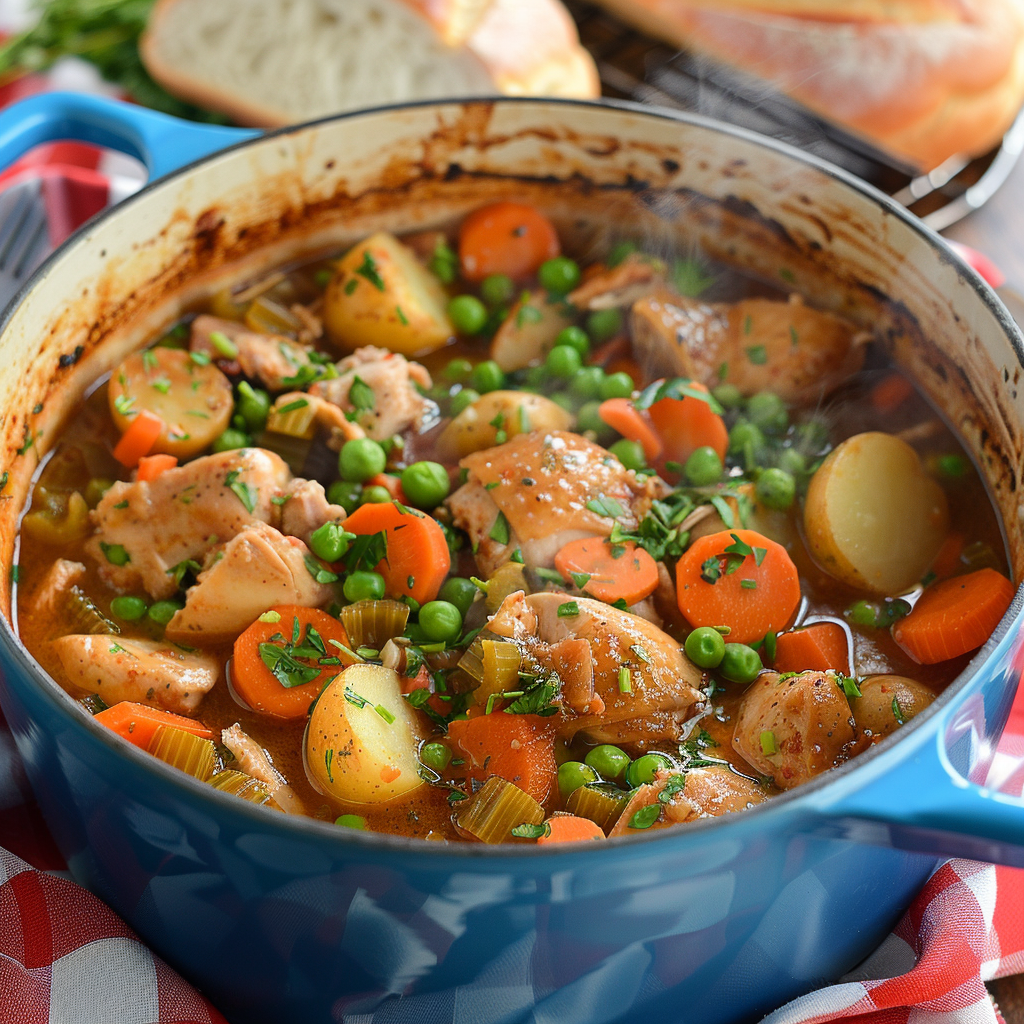Hearty Homestyle Chicken Stew Recipe

Share
In My Family, Nothing Quite Says Grandmother Like Chicken Stew
In my family, nothing quite says “Grandmother” like a pot of homemade chicken stew. Growing up during my homesteading years, Sundays were often reserved for slow-cooked meals like this, with everything from the chicken to the vegetables coming directly from our own land. I vividly remember the chore of plucking feathers after my father butchered the chicken—certainly not a glamorous job, but one that taught me the true value of food. The smell of the stew simmering, with hearty potatoes, carrots, and herbs, filled the house and signaled comfort and nourishment. Even though I no longer live that way, cooking chicken stew keeps me connected to those simpler times and the lessons learned about food and family.
Yield: 6 servings
Ingredients:
- 2 pounds boneless, skinless chicken thighs or breasts, cut into bite-sized pieces
- 2 tablespoons olive oil
- 1 large onion, diced
- 3 cloves garlic, minced
- 4 carrots, peeled and sliced
- 3 celery stalks, sliced
- 4 medium potatoes, peeled and diced
- 1 cup frozen peas
- 6 cups chicken broth
- 1 teaspoon dried thyme
- 1 teaspoon dried rosemary
- 1 bay leaf
- Salt and pepper to taste
- 2 tablespoons flour (optional, for thickening)
- 2 tablespoons fresh parsley, chopped (for garnish)
Instructions:
Prepare the Stew: In a large pot or Dutch oven, heat the olive oil over medium heat.
Add the chicken pieces and cook until browned on all sides.
Personal Tip: Browning the chicken adds depth to the flavor, so don’t skip this step.
Remove the chicken from the pot and set aside.
In the same pot, add the diced onion, garlic, carrots, and celery.
Cook for about 5 minutes, until the vegetables begin to soften.
Cook the Stew: Add the potatoes, chicken broth, thyme, rosemary, bay leaf, salt, and pepper to the pot.
Bring to a boil, then reduce the heat to low and let simmer for about 20 minutes, or until the potatoes are tender.
Personal Tip: If you like your stew to have a stronger herb flavor, feel free to add more thyme or rosemary.
Return the chicken to the pot and stir in the frozen peas.
Simmer for another 10 minutes until the chicken is cooked through and the peas are heated.
Personal Tip: For a thicker stew, mix the flour with a small amount of water to create a slurry, then stir it into the stew and cook for an additional 5 minutes.
Serve: Remove the bay leaf before serving.
Ladle the stew into bowls and garnish with fresh parsley.
Serve hot with crusty bread or over rice.
Personal Tip: This stew pairs perfectly with a side of fresh, warm bread to soak up all the delicious flavors.
Nutritional Information (Per Serving): Calories: 320; Fat: 12g; Saturated Fat: 2.5g; Carbohydrates: 25g; Fiber: 5g; Sugars: 5g; Protein: 28g
Kitchen Tips, Great Ideas, How to Save Money
-
Bulk Buying: Purchase chicken, vegetables, and broth in bulk. These ingredients are staples in many recipes, and buying in bulk can reduce the overall cost. Store them in airtight containers or freeze them to keep them fresh and ready for use.
-
Homemade Chicken Broth: Save money by making your own chicken broth using leftover chicken bones and vegetable scraps. Simmer them in water with herbs and spices, then strain and use in your recipes. This can be more flavorful and cost-effective than store-bought broth.
-
Vegetable Variations: This stew is versatile and can accommodate various vegetables based on what you have on hand. Consider adding bell peppers, zucchini, or green beans for a different flavor profile.
-
Dairy Alternatives: This recipe is naturally dairy-free, but if you want to add creaminess, consider stirring in a bit of coconut milk or a dollop of dairy-free yogurt before serving.
-
Reusable Storage: Invest in reusable silicone bags or glass containers for storing leftover stew. These are environmentally friendly and can save money over time compared to disposable plastic bags and containers.
-
Energy Efficiency: Cook large batches of the stew and freeze portions for future meals. This saves on energy costs and makes meal prep more efficient. You can reheat the stew on the stovetop or in the microwave for a quick and easy meal.
-
Smart Storage: Store leftover stew in an airtight container in the refrigerator for up to five days. For longer storage, freeze the stew in portioned containers and thaw as needed. This makes for a convenient and nutritious meal option on busy days.
-
Ingredient Substitutions: If you’re out of potatoes, use sweet potatoes, parsnips, or butternut squash as a substitute. These alternatives not only save money but also add a unique flavor and extra nutrients to your stew.
-
Learning and Sharing: Engage with online cooking communities for more tips and recipe ideas. Sharing your experiences and learning from others can make cooking more enjoyable and economical. You can discover new techniques, ingredient substitutions, and creative ways to use pantry staples.
-
Flavor Enhancements: Experiment with adding different flavors to your stew, such as a splash of white wine or a sprinkle of smoked paprika, to add a unique twist to your recipe. Fresh herbs like thyme, rosemary, or dill can also enhance the flavor and add a touch of freshness.
It’s So Much Easier to Buy the Chicken Then Raise It!
Buying chicken from the store is convenient and saves time, but choosing quality chicken can make a big difference in your meals. Local, humanely raised chickens often offer better flavor and peace of mind. While they may cost more, the benefits of knowing your food’s source and supporting ethical farming are well worth it. If you can, opt for local or organic chicken, but if that's not possible, make the best choice for your circumstances. Remember, every small step towards more conscious food choices counts!


